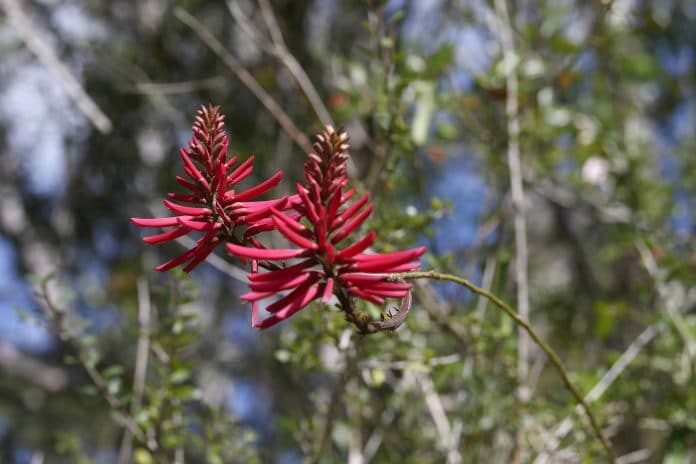If you’re able to stretch your legs on a nice walk or bike ride, you may encounter some of these wildflowers that are blooming right here in Hernando County.
Wildflowers give nature color as well as provide nectar for birds, bees, and butterflies but also an essential food source for animals and insects. We hope you enjoy and continue to follow us as we share with you our Spring Wildflower collection.
Cherokee Bean
Cherokee Bean, otherwise known as Coral Bean, Erythrina herbacea has very showy red, tubular flowers which hummingbirds love. In our area, it usually grows to be 3-5 feet tall before a cold front comes along. Although sensitive to the cold, these hardy plants will come back from the roots. They can grow much taller the further south they are found. The flowers and beans are stunning, but the stalks look best when mixed into a wildflower garden with other blooming beauties. This bright red addition to your landscape can grow in just about any conditions, from sun to shade, and even has good salt-tolerance. Word of caution, this flaming redhead has a dark side, and the beans are deadly to ingest. Keep them away from very young children or orally curious pooches.
Skyblue Lupine
The Skyblue Lupine (Lupinus diffusus) is truly one of my favorites blue flowers of Spring. Lupines diffuse is a sublimely perfect little plant! The leaves are gorgeous by themselves, as they grow low to the ground in clumps. When conditions are right, the hairs on the leaves leave a silvery hue on the medium green leaves. The green of the leaves tends to stand out in otherwise sandy regions, and then it shoots up pastel blue floral spikes that can grow to be 2-3 feet tall. Patches of these lovely annuals/perennials pop up in sandhill woodlands, on roadsides, and even on the beach. I’ve seen photos of the incredible blue flowers against the actual blue sky on beaches, and it is on my bucket list to run across such a site myself.
Pinebarren Frostweed
Also known as rock rose, Crocanthemum corymbosum challenges the assumption that native plants are small and subtle. This yellow show- stopper will demand attention wherever it blooms. The orange anthers contrast the bright yellow petals, and this large flower brings in pollinators from far and wide. It can be found in sandy areas in the full sun. It is not readily available on a commercial basis, as it’s one of those hard-to-propagate fussy natives. But if you take a walk on the wild side, you just may come across one of these jewels.
Whitetop Sedge
Sedges have edges, and Rhynchospora colorat is no exception. Also called Starrush Whitetop, its triangular stems end in a bract that resembles a drooping white flower with green edges. An oddity for a grass-type plant, this dainty slip of a plant is pollinated by insects instead of wind. It loves moist areas and hanging out with rain lilies. They grow to be about 1-2 feet tall. They are quite stunning when seen in mass, but be sure to bend down and check out the amazing detail in this little treasure.
Atamasco Lily
Finally! We get to talk about a lily! Also known as Rain Lily or Zephyr Lily, Zephyranthes atamasco is a precocious little member of the lily family. They pop up in seemingly random patterns after a good rain shower in low, wet areas, but they don’t like it soggy. They are happy little bloomers, but each flower only lasts about two days. That is why they seem to come and go with the rain. They can be used in a landscape, and these bulbs will look great in a flower bed.
Baldwin’s Clematis
Also referred to as Pine Hyacinth, Clematis baldwinii, is not in the true hyacinth family. Clematis refers to climbing, but unlike its bolder northern cousins, this clematis is an upright plant that grows in flatwoods, sandhills and prairies, only in horticultural zones 9a – 10b. That puts us at the northern range of its spread. The exquisite flowers don’t actually have petals, but the sepals are revolute, which means “folding over.” That’s why they look like miniature bells. They grow 1-2 feet tall in the sun to partial shade, in sandy soils. Often overlooked as a weed, the pollinators know a good thing when they find it, and enjoy these blooms to the fullest.
FEATURE: Carolina Wild Petunia (Ruellia caroliniensis)
The Carolina Wild Petunia brings a beautiful splash of lavender in their natural habitat, naturally seen in the wild, of course. They can be seen growing in hardwood forests with moist, well-drained soil in partial to full sun. These beauties bloom around the later part of the spring season and continue to thrive through the summer. The first record of this flower was on April 26, 1958, by George R. Cooley and his staff on a northern slope near Chinsegut Hill.
The common butterflies that visit the Carolina Wild Petunia are the Common Buckeye and White Peacock.

